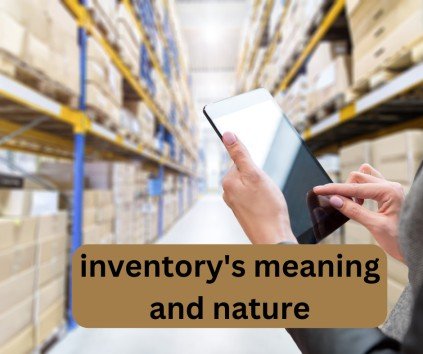Inventory’s meaning and nature. Inventory denotes “stock of goods”. Various authors have defined this word in their own way. In terms of accounting, the word may be used to refer to the stock of finished goods only, while in a manufacturing concern this may include work in process, stores, raw materials, etc.
International Accounting Standard Committee (L.A.S.C) defines inventories as “Tangible property”
1) Held for sale in the ordinary course of business,
2) In the process of production for such sale, or
3) To be consumed in the process of production of goods or services for sale”.
The American Institute of Certified Public Accountants (AICPA) defines
“Inventory in the sense of tangible goods, which are held for sale, in process of production and available for ready consumption”.
According to Bolten S.E., “Inventory refers to a stockpile of product, a firm is offering for sale and components that make up the product”.
Objectives of Inventory Management
Nature/Elements of Inventory
Inventory comprises the following things:
1) Raw material:
It refers to the direct material used in the process of manufacturing a product. It’s important to make sure there are enough raw materials so that the manufacturing process doesn’t stop. The speed and certainty of replenishment are two important factors in determining stock levels:
i) Direct Material:
This is a type of raw material used in the manufacturing process. It has a direct relation to the finished product. For example, wheat is the direct material used in bread-making concerns.
inventory’s meaning and nature.
ii) Indirect Material:
These materials are not actually supplied to the customer as part of the final product. For example, coal used for heating the furnace is an indirect material.
2) Work-in-Progress:
This type of inventory includes partly finished goods and materials. It also includes raw materials which consumed in the manufacturing process but have not been converted into the final product.
3) Consumables:
These are the products that are bought by consumers frequently. These items include stationery items such as pens, paper, pencils, folders, etc. Capital goods such as machines and computers are not included in this category.
4) Finished Goods:
This category of inventory includes the final product which is ready for distribution or sale. Maintenance of such inventory helps in reducing the risks associated with the discontinuation of the production process due to strikes, repairs, etc.
5) Stores and Spares:
This type of inventory is used as accessories to the main products. The main examples of stores and spares are screws, nuts, bolts, etc. Sometimes, the company manufactures or outsources the accessories from the market.
Costs Associated with Inventory
Following are the four major costs associated with inventory:
1) Purchasing Cost:
This is the normal cost of inventory. It includes the purchase price of the product bought from outside and the production costs in case of the goods are produced in-house. This inventory may be valued in a variety of ways including variable pricing and constant pricing.
2) Ordering Cost/Set-up Cost:
Ordering costs are also known as procurement costs and are incurred every time a firm places an order to replenish the inventory. It includes processing costs, inspection costs, and transportation costs.
Set-up costs, on the other hand, are associated with the goods which are produced by the firm itself. It includes production schedule costs as well as the cost of the resources used for production.
3) Carrying Cost:
These costs are also known as storage costs or holding costs. These are the costs. which are incurred for storing inventory. These are influenced by the quantity of inventory as well as by the length of time, e.g., heating and lighting, storeman’s salary and transportation costs, warehouse costs, insurance costs, etc. Carrying costs may be expressed in a variety of ways such as a percentage of the inventory value or as a rate per unit.
4) Stock-Out Cost:
This is the implied cost incurred by a firm when it cannot serve a customer due to a shortage of goods. This occurs due to production delays, strikes, or natural calamities. The firm loses its goodwill when it is not able to serve an order. It may result in loss of sales or backorders which means that the sales are not completely lost but are delayed for some time.

